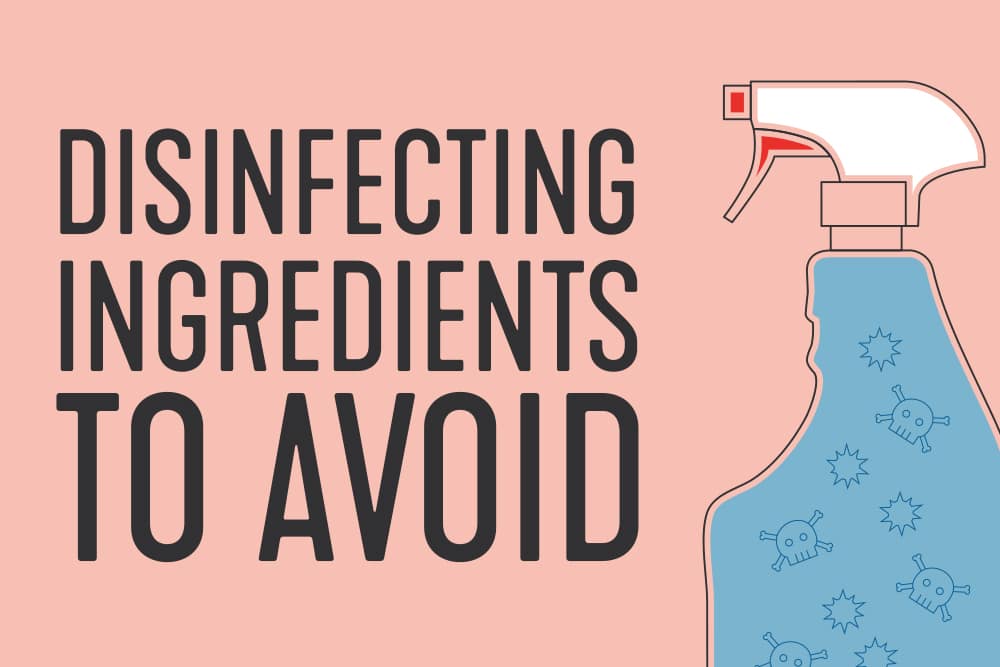Disinfecting is always an important step in protecting ourselves from sickness-causing germs, but it’s been especially important since the pandemic began. However, many conventional cleaning products contain powerful chemicals that can have some pretty scary adverse effects on our health. Fact: daily exposure to cleaning products has been proven to be as damaging to our health as smoking a pack of cigarettes a day over the long term. And that research was on adults!
Children (and, even more so, children with asthma and allergies) are especially at risk when it comes to this exposure. This is in part because given their smaller size, children bear a proportionately higher toxic load from what they eat, breathe and touch relative to adults. Kids are also developing at lightning speed and exposure to cleaning chemicals can damage these developing systems. Researchers estimate chemical exposures contribute to as much as 5% of childhood cancer and 30% of childhood asthma.
Another surprising fact is that about 40% of US children and 30% of US adults have asthma or allergies. The reason this is important is that the CDC recommends that the 2 most common disinfectant ingredients, bleach and quaternary ammonium (quats), not be used around people with asthma or allergies. To help you look for safer disinfectant products, here are the top ingredients to avoid.
Top Ingredients To Avoid For Safer Disinfecting
From fragrances and phthalates to ammonia and quats, there is a laundry list of toxic ingredients that you do not want to be exposing yourself and your family to through your cleaning products. Here are the top two to avoid if you possibly can.
1. Sodium Hypochlorite (Bleach)
Bleach is an effective antimicrobial agent and an extremely common ingredient in household cleaning products and disinfectants. Bleach is rated as one of the most dangerous types of disinfecting ingredients, associated with a long list of adverse health risks including cancer and reproductive toxicity, and is one of the most common sources of deadly poisoning in children. When mixed with other cleaning agents, like ammonia, bleach produces chlorine gas vapors that can be deadly.
Bleach is a respiratory irritant and the CDC recommends that it should be not be used around people with asthma or allergies. (Note that the CDC also recommends avoiding cleaning products with fragrances, given fragrances can also trigger asthma attacks). Many people don’t know that bleach is also an asthmagen, meaning it can cause asthma, not just trigger attacks in people who already have asthma.
Another reason to think twice about reaching for bleach is that its long term use, along with other disinfectants, has been linked to a significantly higher risk of developing chronic obstructive pulmonary disease (COPD). This was one of the few studies looking at the long term impact of disinfectant exposure, and the study assessed lung health of 55,000 nurses in the US over 30 years.
To avoid disinfectants with bleach, avoid products listing sodium hypochlorite or chlorine bleach on their labels.
2. Quaternary Ammonium Compounds (“Quats”)
Quats are a class of compounds that are effective at killing microbes by attaching to the negatively-charged surfaces of bacteria and viruses. Over half of the disinfectants on the EPA’s List N for use against SARS-CoV-2 (the cause of Covid-19) contain quats. These chemicals are found in products ranging from disinfectants to detergents, shampoos and dryer sheets. These compounds have been used in disinfectant products for decades, but scientists are now concerned that we don’t know enough about these chemicals to deem them safe for frequent use.
Quats have been associated with multiple health risks. Examples include allergies & irritation (skin, eye, lung), contact dermatitis, asthma (triggering it in those who already have asthma and new onset in people with no prior asthma), reproductive and developmental toxicity, and promoting “super bugs“. Research has shown quats are linked to reproductivity toxicity in mice, and they have been found in the bloodstream of humans. Research isn’t yet clear on how they enter the bloodstream. The risk of injury is a major concern as well, including eye and mucous membrane injuries from splashes or contact with mists and oral and gastrointestinal injuries from swallowing solutions containing quats.
To avoid quats, look out for products with ingredient names that end in “ammonium chloride”, those that contain benzalkonium chlorides, or even those that contain the terms “antibacterial” or “antimicrobial” as they likely contain quats.
Hypochlorous Acid To The Rescue!
Why should you have to expose your home or workplace to chemicals that can make you sick? We knew there had to be a better way, and that’s why we created Force of Nature. Our little appliance uses electricity to convert tap water, plus a capsule of salt, water and vinegar, into an all-in-one multi-purpose cleaner, deodorizer and disinfectant. Our disinfecting ingredient is hypochlorous acid (HOCl), which is an EPA-registered disinfectant & sanitizer that kills 99.9% of germs, even Staph, MRSA, Norovirus, Influenza A, Salmonella, and Listeria when used as directed. Force of Nature is also on the EPA’s list N, the disinfectants approved for use against SARS-CoV-2. And note that the EPA expects all products on List N to kill all strains and variants of SARS-CoV-2. Best of all, it has no harmful chemicals, fumes or residues, so you don’t need to rinse or wear any protective gear like gloves or masks. It’s also rated 100% top allergen-free and best for sensitive skin by Mayo Clinic’s allergy rating system, because it is free of all top allergens and gentle enough to be used around children and adults with asthma or allergies.
Learn more about Force of Nature, and grab your Starter Kit.




